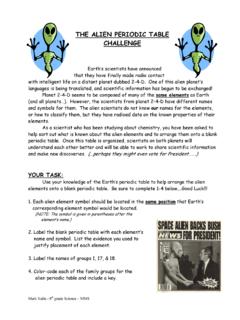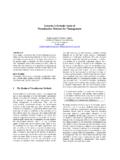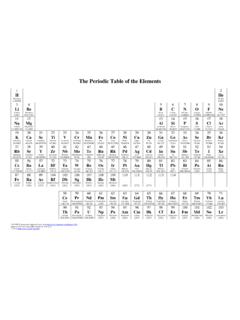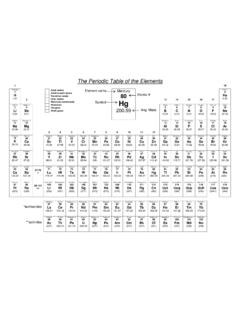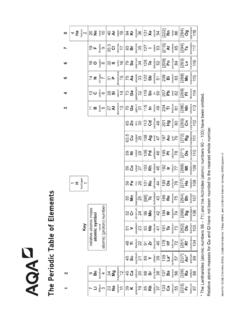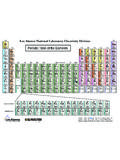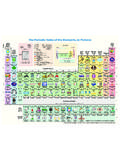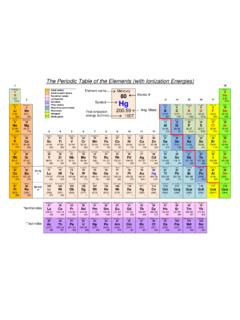Transcription of Periodic Table Basics - The Science Spot
1 Periodic Table BasicsStep 1: Complete the squares for each element by adding the atomic number, name, and atomic 2: Determine the number of protons, neutrons, and electrons in each element. Step 3: Create a Bohr diagram for each 4: Draw the Lewis Structure for each 5: Use the following colors to shade in the square for each element. You should ONLY color in the small square in the upper left-hand corner and not the entire card. Green = Li & NaPink = O & SBlue = Be & MgPurple = F & ClOrange = B & AlRed = C & SiTan = N & PYellow = He, Ne, & ArStep 6: Cut the cards apart and arrange according to atomic number in the pattern shown below. Once you have the cards arranged in the correct order, glue them to a large sheet of construction paper. Step 7: Answer the questions on the back of this worksheet using the information on your Periodic Trimpe 2002 Write the atomic mass at the bottom of the Diagram:Lewis structure:P = ____N = ____E = ____556 Write the atomic number at the top of the the element s name under the Table BasicsName _____1.
2 Which elements had complete outer shells? Give the name and symbol for _____ _____ _____ _____ _____2. What do you notice about the location of the elements in #1? 3. Which elements had only one valence electron?_____ _____ _____ _____ _____ _____4. What do you notice about the location of the elements in #3? 5. What do you notice about the number of valence electrons as you move from left to right across a row or period in the Periodic Table ? (Na Mg Al Si P S Cl Ar)6. What do you notice about the number of energy levels or shells as you move down a group or column in the Periodic Table ? (H Li Na)7. Elements are organized into families according to their physical and chemical properties. Identify the elements that you used in Step 5 that belong to each family based on the number of valence electrons. Give the name and symbol for each Metals - 1 valence electron _____ _____ & _____ _____ Alkaline Earth Metals - 2 valence electrons _____ _____ & _____ _____ Boron Family - 3 valence electrons _____ _____ & _____ _____ Carbon Family - 4 valence electrons _____ _____ & _____ _____ Nitrogen Family - 5 valence electrons _____ _____ & _____ _____ Oxygen Family - 6 valence electrons _____ _____ & _____ _____ Halides - 7 valence electrons _____ _____ & _____ _____ Noble Gases - Complete outermost shell _____ _____, _____ _____, & _____ _____8.
3 What do you notice about the location of the elements in each family? 9. How would you classify hydrogen? Why? 10. Predict the number of valence electrons for each element based on its location in the Periodic Table of Elements. You will need to use the Table in your = _____Lead = _____ Xenon = _____ Potassium = _____ T. Trimpe 2002____B_____P = ___N = ___E = ___Bohr DiagramLewis Structure____Li_____P = ___N = ___E = ___Bohr DiagramLewis Structure____Ne_____P = ___N = ___E = ___Bohr DiagramLewis Structure____He_____P = ___N = ___E = ___Bohr DiagramLewis Structure____C_____P = ___N = ___E = ___Bohr DiagramLewis Structure____P_____P = ___N = ___E = ___Bohr DiagramLewis Structure____S_____P = ___N = ___E = ___Bohr DiagramLewis Structure____Mg_____P = ___N = ___E = ___Bohr DiagramLewis Structure____H_____P = ___N = ___E = ___Bohr DiagramLewis StructureBLiNeHeCPSMgH____N_____P = ___N = ___E = ___Bohr DiagramLewis Structure____Al_____P = ___N = ___E = ___Bohr DiagramLewis Structure____F_____P = ___N = ___E = ___Bohr DiagramLewis Structure____Ar_____P = ___N = ___E = ___Bohr DiagramLewis Structure____Si_____P = ___N = ___E = ___Bohr DiagramLewis Structure____Na_____P = ___N = ___E = ___Bohr DiagramLewis Structure____Be_____P = ___N = ___E = ___Bohr DiagramLewis Structure____O_____P = ___N = ___E =
4 ___Bohr DiagramLewis Structure____Cl_____P = ___N = ___E = ___Bohr DiagramLewis StructureNAlFArSiNaBeOCl







